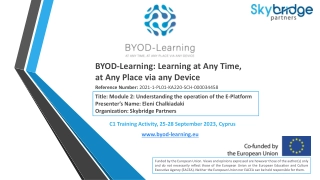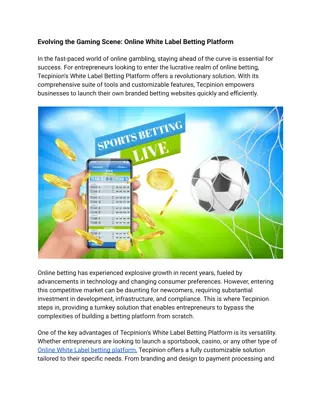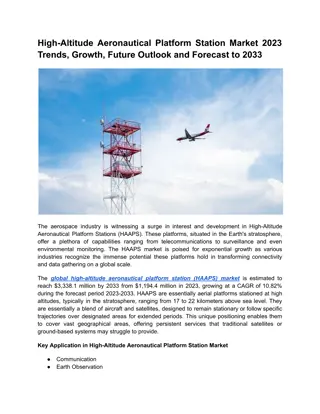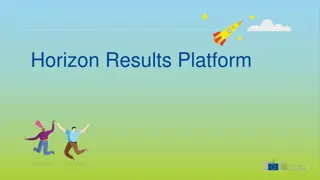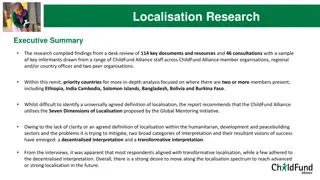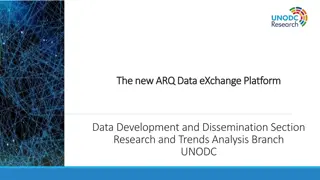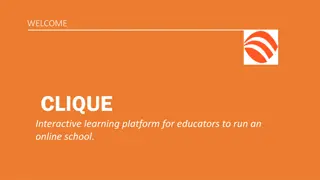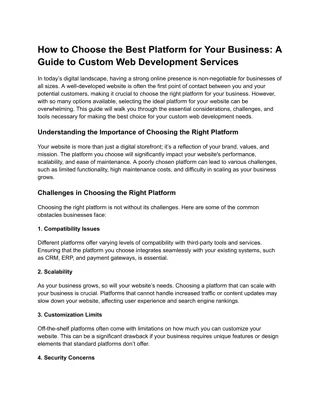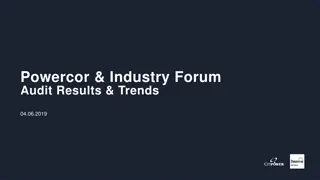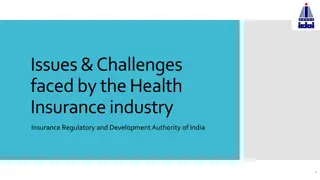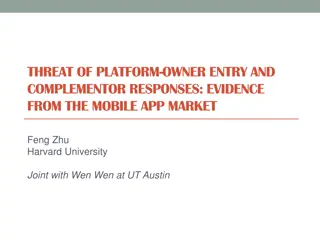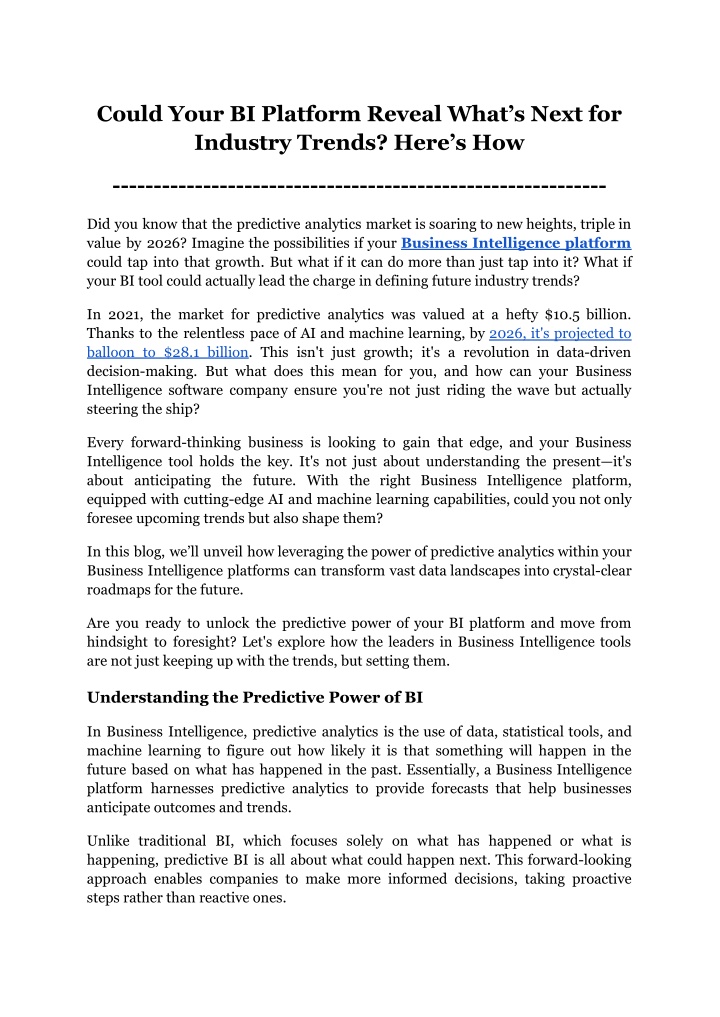
Could Your BI Platform Reveal What’s Next for Industry Trends_ Here’s How
Discover the untapped potential of your Business Intelligence platform as we delve into its ability to forecast emerging industry trends. With the predictive analytics market rapidly expanding, learn how advanced BI tools, powered by AI and machine learning, can transform data into strategic foresight.
Download Presentation

Please find below an Image/Link to download the presentation.
The content on the website is provided AS IS for your information and personal use only. It may not be sold, licensed, or shared on other websites without obtaining consent from the author. If you encounter any issues during the download, it is possible that the publisher has removed the file from their server.
You are allowed to download the files provided on this website for personal or commercial use, subject to the condition that they are used lawfully. All files are the property of their respective owners.
The content on the website is provided AS IS for your information and personal use only. It may not be sold, licensed, or shared on other websites without obtaining consent from the author.
E N D
Presentation Transcript
Could Your BI Platform Reveal Whats Next for Industry Trends? Here s How ------------------------------------------------------------ Did you know that the predictive analytics market is soaring to new heights, triple in value by 2026? Imagine the possibilities if your Business Intelligence platform could tap into that growth. But what if it can do more than just tap into it? What if your BI tool could actually lead the charge in defining future industry trends? In 2021, the market for predictive analytics was valued at a hefty $10.5 billion. Thanks to the relentless pace of AI and machine learning, by 2026, it's projected to balloon to $28.1 billion. This isn't just growth; it's a revolution in data-driven decision-making. But what does this mean for you, and how can your Business Intelligence software company ensure you're not just riding the wave but actually steering the ship? Every forward-thinking business is looking to gain that edge, and your Business Intelligence tool holds the key. It's not just about understanding the present it's about anticipating the future. With the right Business Intelligence platform, equipped with cutting-edge AI and machine learning capabilities, could you not only foresee upcoming trends but also shape them? In this blog, we ll unveil how leveraging the power of predictive analytics within your Business Intelligence platforms can transform vast data landscapes into crystal-clear roadmaps for the future. Are you ready to unlock the predictive power of your BI platform and move from hindsight to foresight? Let's explore how the leaders in Business Intelligence tools are not just keeping up with the trends, but setting them. Understanding the Predictive Power of BI In Business Intelligence, predictive analytics is the use of data, statistical tools, and machine learning to figure out how likely it is that something will happen in the future based on what has happened in the past. Essentially, a Business Intelligence platform harnesses predictive analytics to provide forecasts that help businesses anticipate outcomes and trends. Unlike traditional BI, which focuses solely on what has happened or what is happening, predictive BI is all about what could happen next. This forward-looking approach enables companies to make more informed decisions, taking proactive steps rather than reactive ones.
Key Features of a Predictive BI Platform 1. Data Integration: The Foundation for Predictive Insights Before a BI platform can predict anything, it needs data lots of it, from a variety of sources. Data integration capabilities allow your Business Intelligence tool to pull information from internal databases, social media feeds, market research, and industry reports, creating a comprehensive dataset that is rich and varied. A multinational corporation integrates data from its global sales, customer feedback, and external market conditions into its BI platform. This comprehensive data pool allows for more accurate and encompassing trend analysis, providing insights that are not evident from isolated data sets. How It Proves Predictive Capability: By having a holistic view of data, your Business Intelligence platform is better equipped to identify emerging trends that are consistent across different data sources, increasing the reliability of the predictions made. Ensuring Data Consistency: Integrating data helps standardize information, which is crucial for maintaining consistency. Predictive models require consistent data formats to perform accurately. For instance, integrating customer data from different systems can standardize diverse customer identifiers and purchase histories into a unified format that is more conducive to analysis. Eliminating Data Silos: Data silos occur when different departments within an organization use data that is not accessible by other parts of the organization. Data integration breaks down these silos, ensuring that all relevant data is available for
comprehensive analysis. This is essential for predictive models, which rely on data from multiple business functions to generate accurate forecasts. Richer Training Datasets: Machine learning models, which are at the heart of predictive analytics, thrive on large, diverse datasets. But, only a handful of Business Intelligence software companies can deliver value in such cases. Data integration provides these models with a variety of data points, which helps in uncovering more complex patterns and interactions between variables. This richness significantly improves the model's accuracy and predictive quality. 2 Advanced Analytics: The Engine for Prediction With a robust dataset in place, the next step is analysis. Advanced analytics tools like regression analysis, forecasting, and cluster analysis are not just fancy terms they are powerful techniques that sift through vast amounts of data to spot patterns and predict future outcomes. Foundations of Advanced Analytics in BI Regression Analysis: Regression analysis helps in identifying and quantifying the relationships between variables. For instance, a BI platform might use regression analysis to determine the impact of marketing spend on sales revenue. By understanding these relationships, businesses can make more informed predictions about how changes in one area (like budget adjustments) will affect outcomes (such as sales figures). Forecasting: Forecasting uses historical data to predict future events. This can be as simple as using past sales data to predict future sales or as complex as using economic indicators to forecast market trends. BI tools utilize various forecasting models, from traditional statistical models to more sophisticated machine learning models, to provide businesses with predictions about future conditions. Cluster Analysis: Cluster analysis groups together similar data points based on their characteristics. In a business context, this can help identify distinct customer segments based on purchasing behavior or demographic similarities. Understanding these segments can aid in predicting trends within each group, allowing for more targeted marketing strategies. Using time-series forecasting, a retail company's BI platform analyzes 5 years of customer purchase data alongside seasonal trends and economic indicators. The platform predicts a surge in demand for certain products in the upcoming quarter, allowing the company to adjust its inventory and marketing strategies proactively. How It Proves Predictive Capability: These sophisticated tools allow businesses to move beyond simple guesswork, providing scientifically-backed predictions based on historical data and analytics
models. This capability demonstrates how a BI tool can indeed forecast future industry trends. Enhanced Forecast Accuracy: Advanced analytics improve the accuracy of predictions by analyzing complex datasets and identifying patterns that are not apparent through simple observation. For example, a Business Intelligence tool might predict customer churn by analyzing patterns in customer activity, transaction histories, and engagement levels. The accuracy of these predictions is often significantly higher than those made using traditional methods, proving the predictive capability of the platform. Dynamic Adaptation to Market Conditions: Advanced analytics tools enable Business Intelligence Platforms to adapt predictions based on real-time data. For example, during an unforeseen event like a market downturn, forecasting models can adjust predictions for financial performance or consumer behavior based on the latest data, proving the system s ability to maintain relevance under changing conditions. Quantifiable Business Outcomes: The ultimate proof of predictive capability is the impact on business outcomes. Advanced analytics in BI platforms can lead to tangible business improvements, such as increased efficiency, reduced costs, and enhanced customer satisfaction. For instance, predictive maintenance can foresee equipment failures before they occur, significantly reducing downtime and maintenance costs. 1. Real-Time Processing and Visualization: Turning Insights into Action The real power of predictive analytics is realized when insights can be acted upon quickly. Real-time data processing combined with dynamic visualization tools enables businesses to see and react to trends as they unfold. Suppose, a financial services firm uses its BI tool to monitor real-time transaction data. The platform quickly identifies an unusual pattern indicating potential fraud. This immediate insight allows the firm to halt suspicious transactions before significant losses occur. How It Proves Predictive Capability: Real-time data processing ensures that the insights provided by your BI platform are always relevant and current, allowing businesses to make decisions based on the very latest data. Visualization tools help disseminate these insights across the organization in an understandable format, decision-making. ensuring swift and informed Real-Time Data Processing in Predictive Analytics
Immediate Data Availability: Real-time data processing ensures that data collected from various sources is immediately available for analysis. This immediacy is crucial in environments where conditions change rapidly, such as financial markets or supply chain management. By processing data as it arrives, BI platforms can quickly identify and respond to emerging trends or anomalies. Enhanced Model Accuracy: The predictive models in BI tools depend heavily on the freshness of the data they use. With real-time processing, these models are continuously updated with the latest inputs, which helps maintain their accuracy and relevance. This is particularly important for predictive models used in dynamic sectors like retail or online services, where consumer behavior can shift dramatically in a short time. Visualization for Predictive Insights Interactive Dashboards and Reports: Visualization tools such as dashboards and interactive reports transform complex datasets into understandable and actionable insights. These tools allow users to see patterns and correlations that might not be evident from raw data alone, making it easier to predict future trends. Facilitating Faster Decision-Making: By presenting data in an easy-to-digest format, visualization tools enable quicker decision-making. Stakeholders can assess the current state of affairs at a glance and make informed decisions without needing to parse through extensive reports or raw data tables. A logistics company uses a BI platform that provides real-time dashboards showing vehicle locations, traffic conditions, and delivery statuses. This visualization allows management to predict and mitigate potential delays by rerouting vehicles or adjusting delivery schedules on the fly. Synergy of Real-Time Processing and Visualization Combined Impact on Predictive Analytics: When real-time data processing and visualization work together, they amplify the predictive capabilities of BI platforms. Real-time processing feeds fresh data into predictive models, ensuring that the insights drawn are timely and relevant. Visualization then turns these insights into visual formats that are easy to understand and act upon, even for those without deep technical expertise. Proving Predictive Capability: The ability of a BI platform to combine these features and provide timely, accurate predictions can be seen in industries like finance and health care. For example, real-time stock trading platforms analyze vast amounts of financial data in real-time, allowing traders to predict stock movements based on the latest market trends. Similarly, in health care, real-time data processing and visualization help predict patient care needs, enhancing the ability to provide proactive treatment.
Conclusion As we've seen, the capabilities of Business Intelligence platforms are transforming businesses into forward-thinking, trend-setting powerhouses. The climb from a $10.5 billion industry to a projected $28.1 billion by 2026 is the value that predictive analytics brings to the table. It's an exciting time to be at the front of data analytics, where every piece of data holds the potential to unlock new opportunities and guide strategic decision-making. Your BI platform is not just a tool; it's your gateway to understanding and leading in your industry. With the integration of AI and Machine learning, along with real-time data processing and visualization, you're not just keeping pace with industry trends you're predicting them. Only a limited few Business Intelligence software companies can offer you such cutting-edge technology. If you're looking to not only participate in this growth but also drive it, consider what a Business Intelligence tool like Grow can offer. With a 14-day free trial, you have the opportunity to experience firsthand how Grow can amplify your data s value and convert it into actionable insights. Dive into the 'Grow Reviews 2024' to hear from businesses just like yours that have transformed their strategy and operations using Grow's advanced BI capabilities. Don't let the future be a series of missed opportunities. Instead, make the most of the present with tools that can provide a window into tomorrow s trends. Start your journey with Grow today, and step into a world where your data doesn't just tell a story it predicts the sequel. Your next business breakthrough is waiting grab it with the right BI platform.

